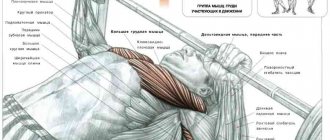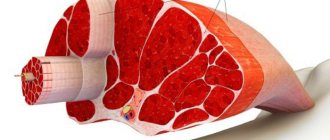Hello dear friends. This article will focus on training men of the older age group; we will answer questions about how to train for those who are over 40 years old or older. Let's talk about the features of strength training for men in adulthood. The emphasis is on beginners and newcomers who take their first steps at the age of 40+.
There are a number of features that distinguish the body of a forty-year-old man from an eighteen-year-old boy; they must be taken into account. The hormonal system experiences serious changes during this period of time, which is commonly called the “midlife crisis.”
Sports veterans
In sports there is a category “veterans”.
It varies in different sports, but most often it begins at the age of 40. This means that a person at 40 can no longer compete on equal terms with twenty-year-olds. Some people at forty years old bench press 200 kilograms or run 200 kilometers, but this can be done by those who have been involved in sports since childhood.
Training after 40 years of age should be divided into two types: with experience in sports and without experience.
If a master of sports returns to training at the age of 40, then this is one topic of conversation; if a librarian, having read the magazine “Physical Culture and Sports”, decided to go to the start or platform, then another.
After 1.5 months we increase weight
After the “trial period” for the body has expired, you can begin to gradually increase the working weight. Your body will get used to physical activity a little and your heart and entire circulatory system will start working. During this period, the weight of the exercises should fluctuate between 55-70% of the one-repetition maximum.
If you can bench press one hundred at a time, then the working weight for you is 55-70 kg. Consequently, the number of repetitions in sets is reduced from 15-20 to 8-12 times. The total number of approaches per workout does not change. If possible, do not neglect rest between exercises and repetitions; try to rest as little time as possible so as not to lose intensity. This is done with the aim of getting into the training time period of 50-60 minutes. Long workouts are fraught with the production of stress hormones, which adversely affect the training process.
Read:
Mass training program
You should not pay special attention to strength training and indicators, this is not a priority, you do not need to press for one time, use projectile weights close to the maximum. The exception is if during this time you have not developed any additional problems with your ligaments, blood pressure or heart, and you feel healthy, then deviations are possible. However, everything is within reasonable limits and under the control of a friend or coach.
When your health is in order, you should devote a couple of weeks to strength training over 3 months, no more. The working weight is 80-85% of a one-time repetition. The number of repetitions in sets is reduced to 5-8, but the rest between sets is increased by 1-3 minutes. The entire volume of approaches per workout is reduced from 15-20 to 12-16.
Do not work with submaximal weights when repeating the exercise 1-3 times. The risk of injury is high. And at the age of 40 or more, they take a very long time to heal, you can drop out of the training process for more than 1 month.
Strength training for men after 40
"You can't teach an old dog new tricks"
A man over forty does not need exotic sets of strength exercises - a set of push-ups, pull-ups and squats is quite enough.
Not all men over forty can do pull-ups, so the GTO standards allow doing pull-ups while lying down.
For strength training, you need to select push-ups, pull-ups and squats in which a man over forty can do 12-25 repetitions using strict technique.
Sarcopenia – why muscle mass decreases with age
Around the age of 30, the male body begins to lose some of its mass. Of course, you don't have to worry about your muscle mass disappearing as soon as you turn 30. However, you should know that every decade your total muscle size will decrease by 3-5%. Experts say that by the end of life, most men will lose about 30% of their skeletal muscle volume.
We advise you to read: What is the difference between circuit and interval training and which is better to choose for weight loss
As you can imagine, the older you get, the more noticeable these changes become. It’s easy to calculate that by your 50th birthday your body will have lost 6-10% of the muscle volume you had at 25 years old. Add to this the age-related decline in testosterone levels, and you get a frustrated man with saggy muscles.
But you should not perceive a decrease in muscle mass as an absolute defeat in front of nature. On the contrary, let this process serve as a signal for you to act. Fortunately, sarcopenia can be slowed down and muscle size can even be increased after age 40-50 and into older age.
Consider how sarcopenia can not only weaken you physically, but also reduce your overall quality of life. If these reasons are not enough to make you move, then think about this...
Yes, ignoring the signs of this disease, you are guaranteed to lead yourself to an early grave. Let's see what you can do to avoid this.
At any age, lifting weights is very beneficial for your body. Below are the advantages of bodybuilding in comparison with other sports disciplines.
I will speak for myself. I have quite a lot of experience in bodybuilding for health. There were also long breaks in classes, but I always knew that I would continue to do exercises with weights. How indescribable feelings of strength and vigor take over you when you train. When you feel how your muscles acquire elasticity and tone and ache pleasantly after exercise, when shapes begin to emerge and when you want to live!
Muscle mass increases.
By the age of 40, an untrained person loses up to 220 g of muscle mass annually with a simultaneous increase in fat. Studies conducted by scientists have shown that people who just started training added up to one and a half kilograms of muscle mass. Similar studies were conducted on 90 year old people. They recorded an 11% increase in muscle mass after weight training.
We recommend reading: What weighs more, fat or muscle?
Blood pressure decreases
Everyone knows that blood pressure levels only increase with age. Studies of people involved in bodybuilding have shown a decrease in systolic and diastolic pressure by up to 3 and 4 percent, which reduces the risk of heart attacks and heart attacks by forty percent (40%)!
Improves digestion
With age, the movement of food in the gastrointestinal tract slows down. This can lead to hemorrhoids, intestinal cancer, and more. other diseases. It has been found that after just a few months of training, the speed of food movement increases by 50%
Bones become stronger
We have already written that as we age, our skeletal system loses a lot of calcium, and because of this, the bones become more fragile. After just a few months of lifting weights, an increase in calcium levels of up to 4% is noted. Just one hour and a half workout increases metabolism by up to 10 percent, which means that excess calories are eliminated that could turn into subcutaneous fat.
The risk of developing coronary disease is sharply reduced
Coronary disease is when the lumen of the arteries leading to the heart decreases. It is caused by cholesterol plaques sticking to the artery walls. Research in this area has shown that after just a few months of training, the level of “good” cholesterol increases and the level of bad cholesterol decreases.
Also, one of the important factors in older people is the decrease in cell sensitivity to insulin. Bodybuilding increases this figure to 20 percent.
As you age, you need more time to rest after training and recover. Don't forget about it!
How to calculate your load level so as not to overdose?
To avoid an “overdose” of sports, you need to control physical activity. You can do this as follows:
1. Subtract your age from the number 220. The result is the maximum allowable heart rate for you.
2. It should be taken into account that older people do not need to achieve this indicator. They should stick to 60-65% of this figure.
Let's check this with an example, if you are 65 years old.
220 - 65 = 155 beats per minute - this is the maximum allowable heart rate for 65-year-olds.
But this is too high for normal activities, so you need to stick to a heart rate that corresponds to 60-65% of this maximum value. It turns out that at this age the optimal heart rate during sports should be within 90-100 beats per minute.
The pulse was racing. What is “heart age” and how to make it “younger”? More details
Is it possible to go winter swimming?
In old age, winter swimming is permissible only if you have been doing it all your life. There are entire families of so-called “walruses” for whom this is an absolutely normal and common practice. For an unprepared body, extreme temperature changes can result in reflexive cardiac arrest and instant death. And this applies not only to winter swimming, but also to simply swimming in an ice hole on Epiphany or even jumping into the snow after a bath or rubbing it. If you really want to try hardening, start by wiping it off with a damp towel at home in the bathroom.
Benefits of exercising after 60 years of age
- Physical and mental abilities are maintained at a high level.
- The functioning of the cardiovascular system, joint mobility and blood circulation improve.
- Strength and muscles develop.
- Bone density increases.
- Aging slows down and hormonal composition rejuvenates.
- Positively affect the nervous system and immunity.
- Depression goes away.
- Blood pressure normalizes.
5 simple office exercises that will make you more productive
Is it possible to lose weight by doing Nordic walking?
Doctors strongly recommend training for atherosclerosis, arterial hypertension, diabetes, osteoporosis and other chronic diseases. The famous Italian physiologist Angelo Mosso once said that exercise can replace many drugs, but not a single drug in the world can replace exercise.
Bodybuilding at 40 - the beginning:
To avoid injury and get maximum efficiency from a sport such as bodybuilding for beginners, anyone over 40 years old should remember the tips and recommendations compiled by coaches who were previously involved in bodybuilding and continue their training, only making some changes:
Physical activity at the initial stage of training must be increased gradually. After prolonged stagnation, the body is not adapted, the muscles are weak and less resilient.
Start working with minimal weight. Lifting heavy to medium weights is the best way to increase your strength potential and build muscle. But when working with heavy weights, you should take into account your characteristics so as not to damage muscle fibers and not overload your joints. Train in the 10-12 rep range until you feel that the exercises with this weight are easy.
During exercises, do not make sudden body movements; be guided in your actions with optimal amplitude so as not to damage ligaments and joints.
After 50 years, a set of bodybuilding exercises should consist of several sets of 10-15 repetitions, this will minimize the load on the joints.
It is necessary to monitor the technique of performing exercises to protect yourself from injury.
It is recommended to stretch before and after training, devoting at least 10 minutes to this.
As you age, your body needs more time to restore strength and energy. Training should be done 2-3 times a week.
Don't ignore back or lower back pain. If you experience pain, avoid deadlifts and squats. If you have painful knee joints, it is not recommended to do squats and lunges; if you experience pain in your shoulders, avoid the bench press and standing “military” press.
Aerobic exercise is necessary for good health and well-being; it strengthens the heart. Aerobics should be done 2-3 times a week for 40 minutes.
Don't forget about nutrition - this is an important aspect in training. The daily diet must comply not only with the established canons of a sports diet, but also be selected according to the age-related needs of the body.
Recovery
After every tough workout, regardless of age, the body needs to get back to normal and recover. The main mechanisms here are food and sleep. Most people exercise either early in the morning before work or in the evening after work. In both cases, it is important to give the body material (food) to recover after exercise. You won't die if you don't do this, but over time, refueling your body well after workouts will have its bonuses.
There are thousands of studies that support the benefits of eating after exercise. Try to eat within 30 minutes of finishing your class. Don't be afraid to include carbohydrates in these meals as your body needs to replenish its energy reserves.
As you age, one of two things will happen to you: either you will realize that bad decisions do not lead you anywhere good, and eating a fast food hamburger causes discomfort for several days, or you will come to the conclusion that a six-pack on your stomach is no longer so important like a glass of wine and a delicious dinner. Only you can decide what is right for you, but to successfully play sports after 40, you will have to make a choice in favor of the first option much more often.











